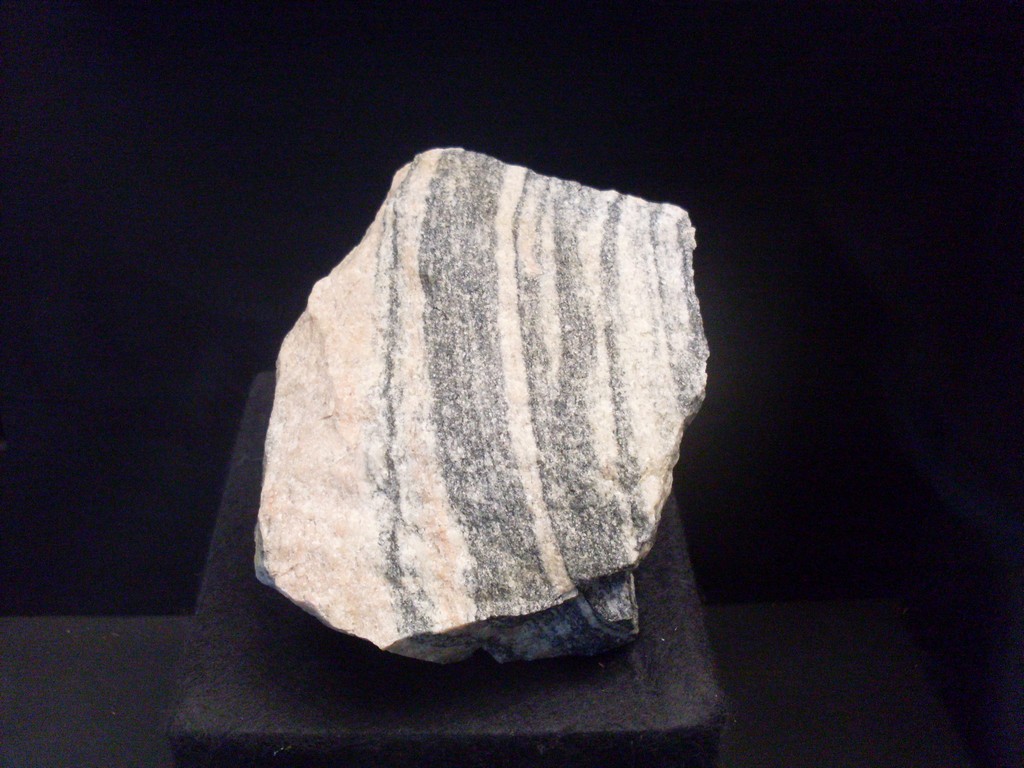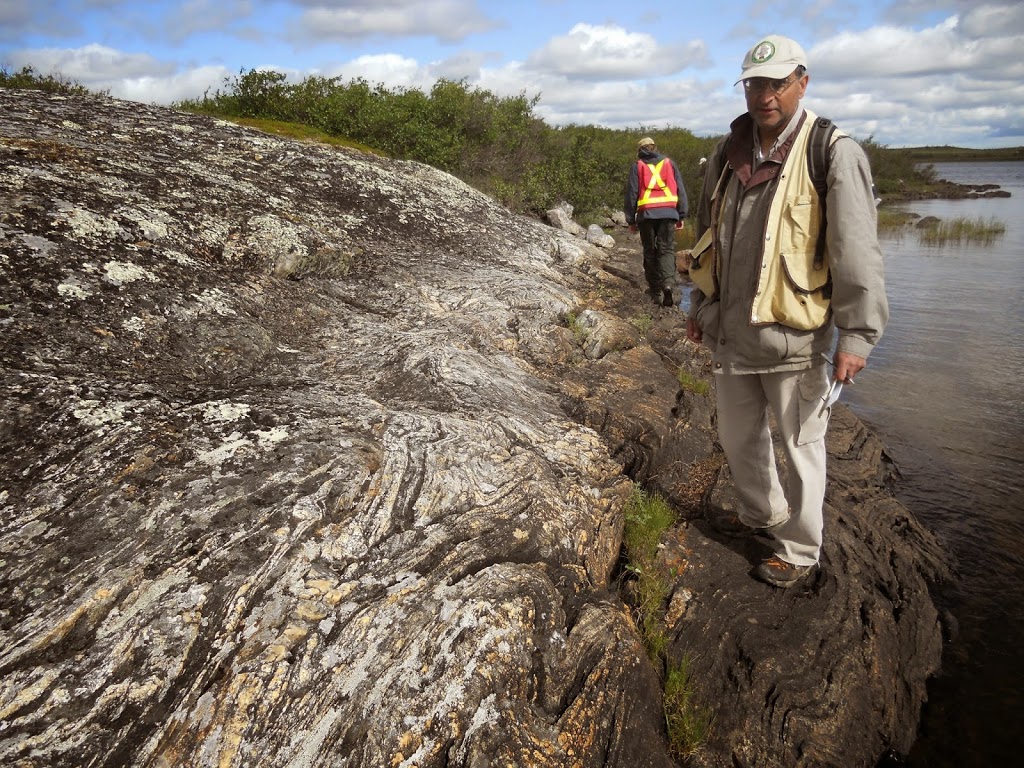When did Earth really become Earth? We’ve learned about how the solar system formed and the earliest stages in Earth formation in the case study exploring the nebular theory and the formation of the solar system. Early Earth grew through the process of collision and accretion of nebular material that ranged in size from space dust to planetesimals, perhaps some as large as small planets. We have dated Earth at 4.567 billion years (Ga) based on lead isotope data from meteorites [1]. Meteorites are the “ingredients” that formed Earth and the other terrestrial planets. This “birth of Earth” date is assigned to the onset of accretion, not at a point in which Earth had largely attained its full, accreted mass [2], [3].
The Hadean
Earth’s first eon of geologic time is appropriately named the “Hadean” with reference to Hades, the God of the Underworld in Greek mythology. The Hadean is often described as “Hell on Earth,” the time when an extremely hostile environment existed with magma oceans boiling on the surface and noxious gases and steam enveloping the young planet. Perhaps the accompanying picture is an analogy. In this extreme environment, no life, as we know it, could possibly survive.

So when can we say, “there you have it – Earth is now Earth!”? Perhaps if we could find the first rock formed on Earth, we could assign Earth’s true age as the inception of a solid surface.
The geologic time span of Hadean contains no Eras or Periods because we know so little about what happened as only trifle bits of Earth material remain. The Hadean as it appears on the geological time scale below indicates that its beginning is approximate. The little clock located at the divisions of time on the right side of the scale above the Hadean indicate that the dates chosen are somewhat arbitrary as geologists continue to examine remnant mineral and rock evidence.
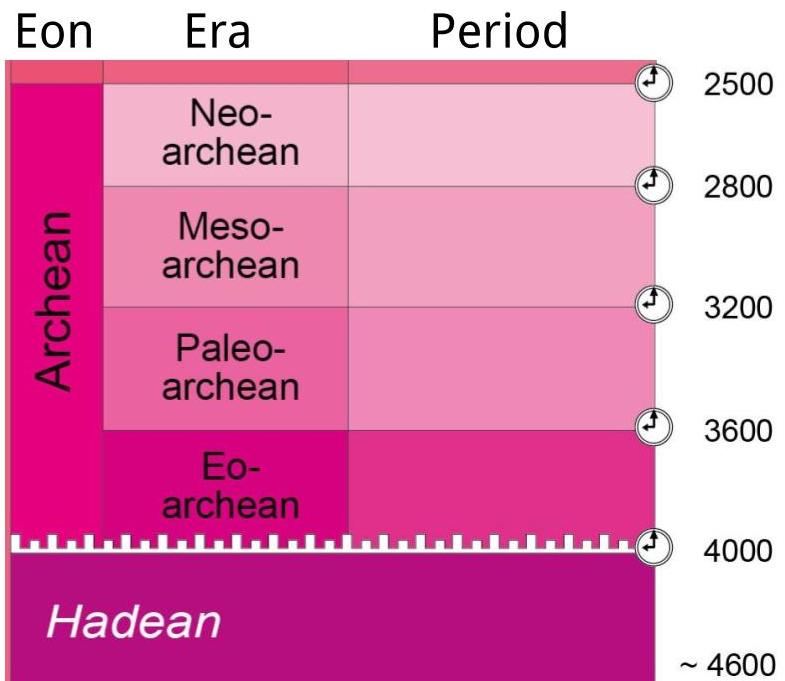
Events that shaped the Hadean
Differentiation of Earth’s Interior
What evidence do we have of Earth shaping events occurring in the Hadean? Planetary geologists theorize that toward the end of the accretionary stage in Earth formation, 4.5 – 4.6 Ga, Earth was pummeled by larger, planetesimal-sized space debris. Planetesimals were other “wanna-be” planets traveling in the same orbit as the developing Earth. They were massive in their own right, but the developing Earth was larger and able to withstand their impacts and remain intact. The energy of these massive collisions melted the surface of the young planet resulting in the formation of vast “magma oceans.” Energetic radioactive decay of unstable elements added to the heat production from inside the early Earth. This double whammy of interior and exterior heat generation may have melted the entire planet, or turned it into a thick, slushy mass of highly convective molten rock material. [1], [2].
This allowed the Earth, and other developing planets in our solar system, to go through a process of differentiation where the heaviest, siderophile (iron associated) elements migrated toward the central core while the lighter lithophile (lithosphere concentrated) elements rose toward the surface. Differentiation happened very quickly with respect to the immensity of geologic time – over the span of several tens of millions of years. Differentiation was not a wholesale turnover of the entire interior of the planet but more like a percolation of siderophile elements through the slushy magma ocean (see image below).
![Hypothetical core-mantle differentiation processes: Percolation, diking, and diapirism. After Rubie et al. (2015).[X] By AlexInMetal - Own work, CC BY-SA 4.0, https://commons.wikimedia.org/w/index.php?curid=76607390](https://opengeology.org/historicalgeology/wp-content/uploads/2020/07/Core-mantle_differentiation_processes-1.png)
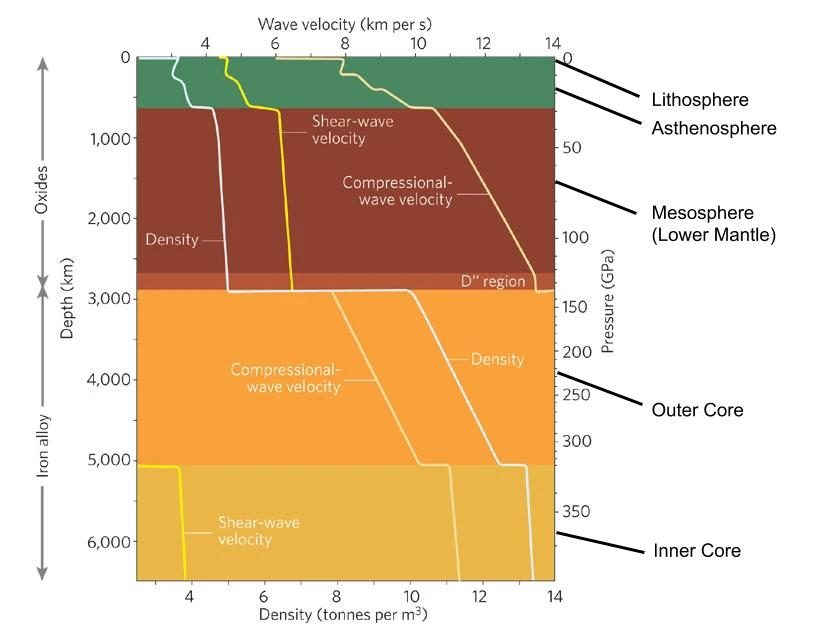
Earth’s first crust
As differentiation proceeded, the light-element-enriched magma ocean at the surface was exposed to the chill of space and a thin, early crust began to form. Meteors, asteroids and comets continued their impact unabated, puncturing the earliest crust and allowing the magma, hidden just beneath, to flow again. The composition of this earliest crust was similar to very rare ultramafic rock komatiite, a volcanic rock largely composed of the mineral olivine. Komatiites are very rare in Earth’s rock record, almost entirely restricted to rock of Archean age. [6] The komatiites were largely derived from the very hot mantle of the young Earth, and pooled on the surface as lava. As Earth continued to cool and the mantle solidified, generation of highly ultramafic magma that has made its way to the surface has been rare. [7]
A quick review of magma composition
Differentiation produced our iron-dominated inner and outer core and silicate-dominated rock material of the mantle and ultimately, the crust. Silicates are minerals that are largely composed of the elements of silicon and oxygen bound together with other lithophile elements including aluminum, calcium, potassium, sodium, and magnesium. Not all of the iron migrated to the core. In the early Hadean, the Earth was continually being bombarded by space debris that contained all of Earth’s natural elements in varying percentages. We can think of the composition of the magma ocean as being silica (silicon and oxygen) dominated and relatively homogeneous. The first crust, composed of komatiite, represented this composition. This convecting ocean of silicate mush brought diapirs (rising teardrop shaped blobs) of deep magma ocean material toward the surface where it pooled and cooled in thick komatiite masses. These heavy, dense komatiite masses dripped back into the magma ocean for recycling. This remelting process further differentiated the early crust. Eddys of convecting magma near the surface partially melted the komatiite. This “partial melt” was more silica enriched because the minerals in the komatiite with the most silica would be first to melt (see discussion on Bowen’s reaction series to understand this process). This is referred to as an “evolved magma,” not primary, but remelted and more silica enriched. Silica enriched magmas are lower in density and more buoyant and can be envisioned as rising to the surface like ice cream in a rootbeer float. This evolution of magma leads to the varying compositions we recognize today in the classification of igneous rock. Notice where komatiite appears on the diagram below. As magma evolution proceeds, the composition becomes more silica enriched, creating magma that becomes increasingly more “felsic” in composition.
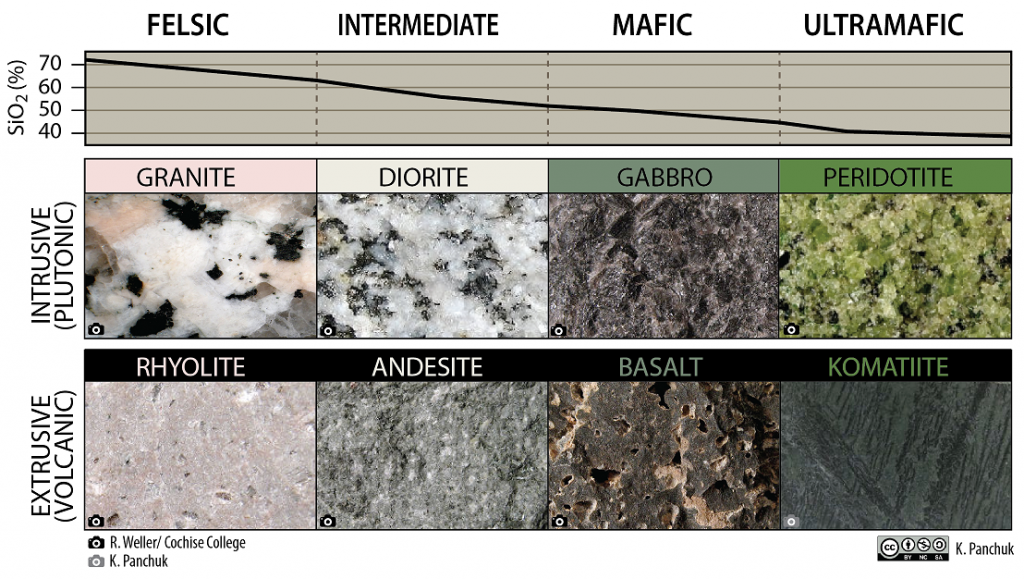
Did I get it?
The Hadean
Earth’s Oldest Rocks
The Jack Hills Zircon
What followed the formation of thin, perturbed, komatiite crust is highly debated and an area of fervent geological research. Insight into the evolution of the earliest crust was unknown until the discovery of Hadean age zircons from the Jack Hills area in southwest Australia (see map). Zircon is a small, durable mineral with the chemical formula ZrSiO4. It is a common mineral in felsic rock with the composition similar to that of the continental crust, like granite. It is not a common mineral of the rock of the ocean crust, like basalt and does not occur in the earliest rock of the crust, komatiite.
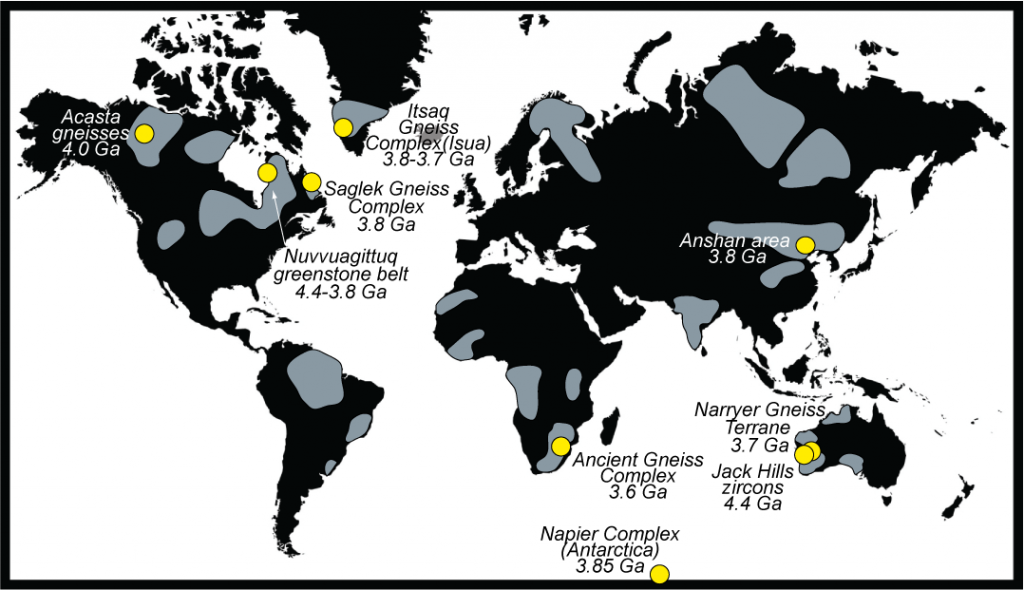
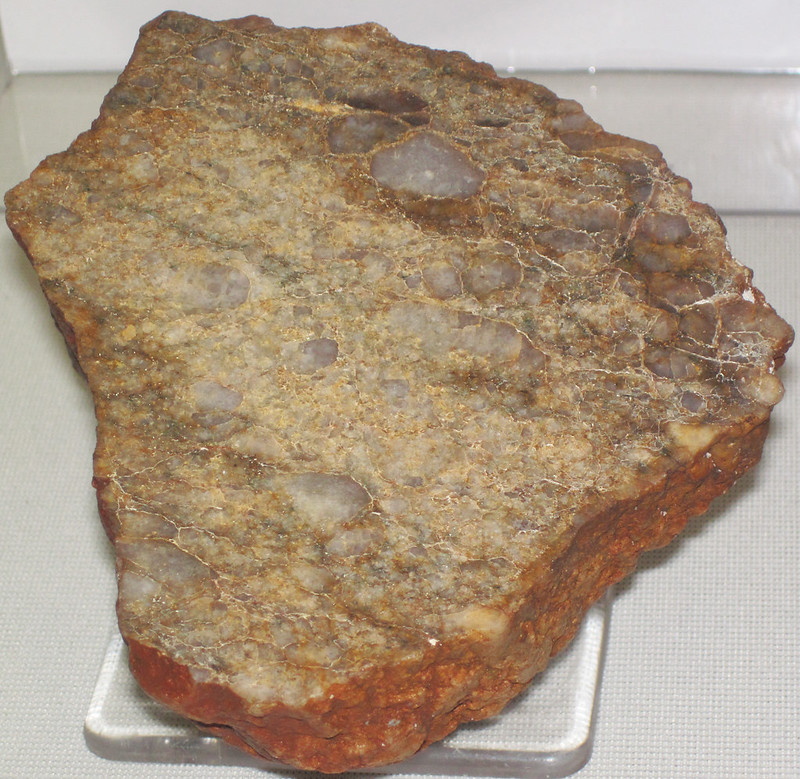
In the mid-1980s field geologists sampled a metamorphosed sedimentary rock (metaconglomerate) from the Jack Hills. The metaconglomerate is dated as Archean, approximately 3.6 Ga. The detrital sedimentary particles found within the metaconglomerate are, of course, older than their deposition as gravel. The environment of deposition of the original conglomerate is thought to be an alluvial fan, where sediment derived from the weathering and erosion of mountains were moved by water and deposited in an adjacent valley. Small zircon crystals were extracted from the metaconglomerate for analysis. The zircons were originally part of the rock that composed these earlier mountains. Remnants of these mountains have not been discovered and have most likely been erased from Earth’s surface by erosion.
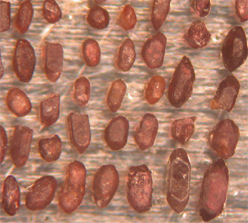
Zircon is a small but mighty mineral. It is one of Earth’s little timekeepers. Zircon typically forms during the crystallization of magma where radioactive uranium can substitute for zirconium in the mineral lattice. Following crystallization, the radiometric clock starts ticking. The unstable radioactive uranium atoms break down through a process known as “decay.” The atoms lose subatomic particles and emit energy. Particle loss includes a decrease in the number of protons which ultimately changes the uranium to lead. The rate of this decay is well known and allows scientists to very accurately date the zircon. Radiometric dating analysis of the Jack Hills detrital zircon grains yield dates as old as 4.404 Ga! This is the oldest Earth material discovered to date, formed merely ~150 Ma after the inception of Earth. That is amazing!!! This tells us that in those 150 million years, the entire Earth was largely formed, its interior differentiated, it cooled enough to have a solid crust of komatiite, and, remelting produced evolved magma where the zircon crystallized in solid rock similar to the composition of our continental crust today. WOW!!! (The method of dating the zircon is discussed more fully in the chapter on Geologic Time).
This discovery has significantly advanced our understanding of the Hadean environment and the evolution of the crust during the Hadean. The discovery of the zircon means that within the first several hundred million years of Earth’s existence, crust of varying composition existed, some of which was more felsic in composition, very much like the continental crust that exists today. This provides significant insight into the processes at work in the Hadean as this type of rock is continuously being formed and reformed through plate tectonic processes today.
Analysis of oxygen isotopes data from the zircon have revealed even more incredible evidence about the environment that existed during the very early Hadean. Oxygen has several isotopes, 16O is most abundant with 8 protons and 8 neutrons existing in the nucleus. 17O and 18O also exist in much less abundance. 18O is concentrated in an aqueous environment, such as oceans, as the lighter 17O and 16O will preferentially evaporate. Analysis of the relative amounts of different isotopes of oxygen 16O and 18O (ratio denoted with the lowercase Greek delta δ18O) in the Jack Hills zircon are skewed toward “heavy” 18O, as opposed to the more common “light” 16O. This heavy oxygen signature in rock is an indication that it formed by cool, wet, sedimentary processes at the Earth’s surface. Thus, the magma that eventually gave rise to the zircons is theorized to have been formed from what had once been sediments deposited on the floor of an ancient ocean [3]. So not only was the very young Earth capable of making felsic-composition crust, it also was cool enough to have liquid water in oceans. These are surprisingly familiar conclusions about a “hellish” young planet.

Since the discovery of the Hadean age zircon in the Jack Hills area of Australia, other detrital zircons have also been discovered in Archean age rock in other parts of the world. See the map at right.
The Nuvvuagittuq Greenstone Belt

Dating of the rock from the Nuvvuagittuq Greenstone Belt (NGB) has been controversial but, if accepted, may actually provide a glimpse of Earth’s earliest crust. (Read more about Greenstone Belts here). The NGB is located in northern Quebec, on the eastern shore of the Hudson Bay (See Archean Craton map above). Metamorphosed mafic and ultramafic volcanic rock dominate the NGB. The fact that these are volcanic rocks erupted in an ancient ocean is documented by the presence of lava pillows. Lava that erupts underwater forms conspicuous pillow shapes as a crust solidifies instantly around the oozing lava as it spills out underwater.
Another rock type included in the NGB is banded iron formation. BIFs (as they are affectionately known) are sedimentary rocks that also indicate an ocean environment as these sedimentary iron minerals form and settle out of the water column. (Read more about the formation of BIFs here). Intrusive mafic and ultramafic dikes also occur within the NGB.
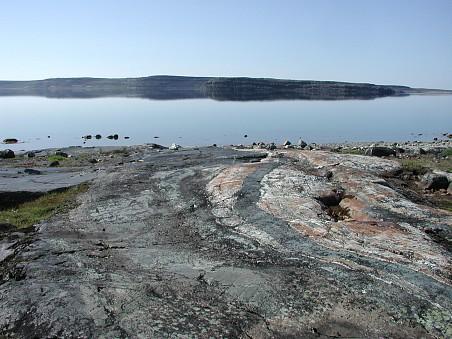
The NGB is bounded by a felsic intrusive rock known as a tonalite (see map below). Both the NGB and the tonalite are cut across by a similar type of felsic rock called a pegmatite. The tonalite and pegmatite intrusive bodies contain zircon needed for U/Pb radiometric dating which has provided an accurate date of 3.77 Ga. Due to the cross-cutting relationship of the intrusive rock to the NGB, this provides only a minimum age for the NGB of 3.77Ga [10] [11]. Further investigation is necessary to understand the maximum age.
The greenstone rocks of the NGB are remnants of ancient ocean crust with a mafic to ultramafic composition (see composition chart above). Rocks of ultramafic composition do not contain zircon and mafic rocks rarely do. Zircon is a mineral that is typically found in igneous rock more felsic in composition, like granite. Uranium-lead (U/Pb) isotopic dating is the “gold standard” for accuracy, particularly in very old rock. A lack of zircon in the NGB will call into question any other method used to provide dates.
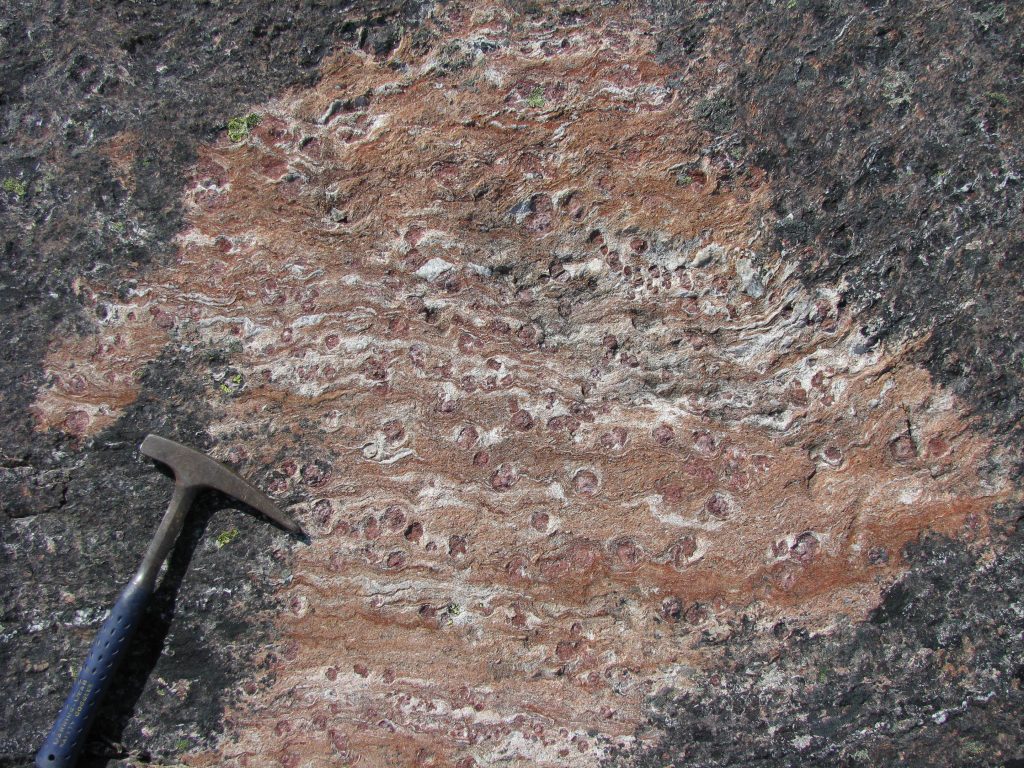
In 2008, Jonathan O’Neil, a young PhD student from McGill University in Quebec, Canada, challenged the assumed date for NGB by investigating an odd looking amphibolite patch in the NGB (picture). An amphibolite is a metamorphosed mafic rock therefore, zircon is not present. O’Neil used a dating technique and isotopic ratio comparisons of the rare but ubiquitous elements of samarium (Sm) and neodymium (Nd). Using this technique, O’Neil determined the actual age of the NGB to be 4.28 Ga [12]. Further analysis of additional samples since then has pushed the date back even further to 4.31 Ga [11]. If true, the NGB rock would represent the oldest preserved Hadean age rock found on the planet.
Not all geologists investigating these rocks concur with O’Neil’s findings. Their interpretation of the isotopic data and comparisons propose that the isotopic signatures represent only that the NGB was derived from pre-existing rock of Hadean age and that the NGB age of formation is Eoarchean (3.7 Ga). This controversy is sure to continue until zircon is found within the NGB. Are you intrigued by the search for the Earth’s oldest rocks? Consider pursuing graduate study in geology. Much of the NGB extent has yet to be sampled.

Earth’s oldest fossils?
The Nuvvuagittuq Greenstone Belt continues to give. In 2017 a team of researchers presented their findings on what they believe to be traces of life found in the banded iron formation of the NGB [13]. Their microscopic investigation of the BIF revealed small tubes made of the iron mineral hematite. These tubes match the shape and size of those made by bacteria in modern hydrothermal vent environments. The bacteria use the iron for their metabolism. The researchers also discovered the mineral graphite in the BIF which is composed entirely of carbon. The graphite likely formed by metamorphism of organic material as it contains reduced levels of the heavy carbon isotope, carbon-13 (13C). Lifeforms are preferential in selection of the lighter isotope of carbon, carbon-12 (12C).
If this discovery holds true, this will be the oldest evidence of fossil life yet discovered. The NGB banded iron formation exists within the NGB and can be interpreted as having been deposited on the ancient sea floor represented by the greenstone. This NGB has been unquestionably dated by cross-cutting igneous intrusions at 3.77 Ga. This would pre-date any fossil evidence previously discovered by several hundred million years (see In the Beginning). If O’Neil’s age for the NGB holds up, then the fossils may perhaps be as old as 4.31 Ga.
Did I get it?
Acasta Gneiss and Nuvvuagittuq Greenstone Belt
Summary
The oldest minerals from Earth’s crust yet discovered are the zircons found in Archean metamorphosed sedimentary rock from the Jack Hills of southwestern Australia. Analysis of the zircon consistently provides dates over 4.0 Ga with the oldest being 4.4 Ga. The rock in which the zircon originally formed would have been some of the very oldest continental crust to exist; unfortunately, the original rocks that supplied these zircons are most likely long gone. The oldest intact rock found on Earth to date is from the Acasta Gneiss Complex of northwest Canada. U/Pb dates of zircon from the gneiss reach into the Hadean Eon at 4.02 Ga. Rock from the Nuvvuagittuq Greenstone Belt in northern Quebec, Canada does not contain zircon as it is mafic to ultramafic in composition and represents ancient ocean crust. Alternate isotopic dating techniques yield a much older reach back into the early Hadean of 4.31 Ga. Controversy within the scientific community does exist concerning this date and investigation continues.
Geologists continue to search Archean cratons for slivers of Hadean crust. More discoveries are assured which will continue to advance our understanding and knowledge of the environment of the earliest time of Earth.
References and Further Reading
[1] Amelin, U. (2018) Early Solar System Materials, Processes, and Chronology. In: Van Kranendonk, M and Bennett, V and Hoffmann, E, (eds.) Earth’s Oldest Rocks. (pp. 3-26). Elsevier: Amsterdam, Netherlands.
[2] Caro, G. (2011) Early Silicate Earth Differentiation. Annual Review of Earth and Planetary Sciences 2011 39:1, 31-58. https://doi.org/10.1146/annurev-earth-040610-133400
[3] Cavosie, A; Valley, J; Wilde, S; (2018) The Oldest Terrestrial Mineral Record: Thirty Years of Research on Hadean Zircon From Jack Hills, Western Australia. In: Van Kranendonk, M and Bennett, V and Hoffmann, E, (eds.) Earth’s Oldest Rocks. (pp. 255-273). Elsevier: Amsterdam, Netherlands.
[4] Romanowicz, B. Using seismic waves to image Earth’s internal structure. Nature 451, 266–268 (2008). https://doi.org/10.1038/nature06583
[5] Dziewonski, A. M. & Anderson, D. L. Preliminary reference Earth model. Phys. Earth Planet. Inter. 25, 297–356 (1981).
[6] Barnes, S; Arndt, N; (2018) Distribution and Geochemistry of Komatiites and Basalts Through the Archean. In: Van Kranendonk, M and Bennett, V and Hoffmann, E, (eds.) Earth’s Oldest Rocks. (pp. 103-132). Elsevier: Amsterdam, Netherlands.
[7] Herzberg, C., Condie, K., & Korenaga, J. 2010. Thermal history of the Earth and its petrological expression. Earth and Planetary Science Letters, 292(1-2), 79-88. https://doi.org/10.1016/j.epsl.2010.01.022
[8] Reimink, J; Bauer, A; Chacko, T; (2018) The Acasta Gneiss Complex. In: Van Kranendonk, M and Bennett, V and Hoffmann, E, (eds.) Earth’s Oldest Rocks. (pp. 329-345). Elsevier: Amsterdam, Netherlands.
[9] Roth, A.S.G., et al., 2014. Combined 147,146Sm‐143,142Nd constraints on the longevity and residence time of early terrestrial crust. Geochemistry Geophysics Geosystems 15 (6), 2329-2345. https://doi.org/10.1002/2014GC005313
[10] Cates, N. L. & Mojzsis, S. J. Pre-3,750 Ma supracrustal rocks from the Nuvvuagittuq supracrustal belt, northern Québec. Earth Planet. Sci. Lett. 255, 9–21 (2007).
[11] O’Neil, J; Carlson, R; Papineau, D; Levine, E; Francis, D; (2018) The Nuvvuagittuq Greenstone Belt: A Glimpse of Earth’s Earliest Crust. In: Van Kranendonk, M and Bennett, V and Hoffmann, E, (eds.) Earth’s Oldest Rocks. (pp. 349-374). Elsevier: Amsterdam, Netherlands.
[12] O’Neil, Jonathan & Carlson, Richard & Francis, Don & Stevenson, Ross. (2008). Neodymium-142 Evidence for Hadean Mafic Crust. Science (New York, N.Y.). 321. 1828-31. 10.1126/science.1161925. On ResearchGate.
[13] Dodd, M., Papineau, D., Grenne, T. et al. Evidence for early life in Earth’s oldest hydrothermal vent precipitates. Nature 543, 60–64 (2017). https://doi.org/10.1038/nature21377
____________________
